Regenerative Ag Verification 101 Pathway:
CIBO Lab: Forecasting the Effects of Weather on Land
By Adam Pasch
It’s one thing to forecast the weather — it’s quite another to see how weather will affect individual parcels of land in an upcoming planting season. There are, after all, myriad variables at play, including soil quality, drainage ability, type of crop, and much more.
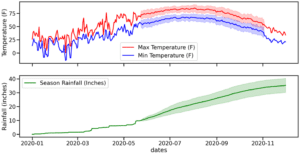
To that end, our proprietary CIBO Lab Yield Simulator blends observed weather data with state-of-the-art seasonal predictions to simulate a range of possible weather scenarios for the new planting season. Our proprietary software platform simulates crop development, from planting to harvest, under a variety of forecast weather scenarios and management strategies. This work provides a range of outcomes and, as the growing season progresses, the prediction’s accuracy improves.
The end result: farmers, landowners, and speculators can create their own custom inputs to track and predict crop growth at each critical moment in a growing season (read more: How Does CIBO Model Crop Yield?).
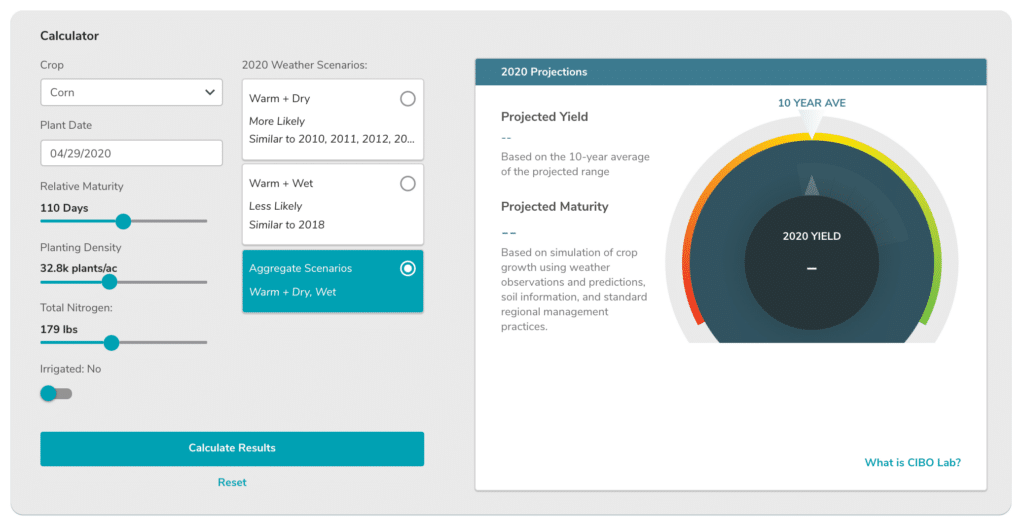
Predicting crop yields involves evaluating land potential using multiple data layers, including satellite imagery, weather, soil, parcel records, and more. CIBO Lab incorporates proprietary machine learning and AI, as well as our subject matter expertise in soil, weather, and agronomy, to predict yields for current and future growing seasons on scales from a sub-field to the continental United States — and beyond. CIBO’s unique capabilities allow for comparisons and experiments to be done across many different potential weather and management scenarios.
We designed the Yield Simulator to help users understand how different factors can impact the predictions of yield and maturity date on any given parcel. Users can customize results by editing inputs in the calculator or clicking Calculate Results with default values based on regionally common farming practices. By inputting their own specific data, users can see the impact of different weather on yields and maturity date.
Let’s look at an example to see this in action.
Suppose we have a parcel of land where corn is to be planted. We can simulate the impacts of different weather scenarios on end-of-season yield and maturity date predictions. Let’s look at the prediction using the Aggregate Scenarios or all possible weather scenarios, which results in predicted yield 13% higher than the 10-year average; and the projected maturity date range is between August 22 and September 8.
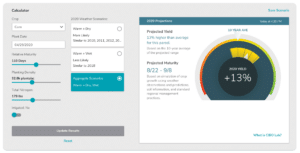
There are two scenarios for this particular parcel: Warm and Dry and Warm and Wet. By looking at the Yield Simulator, we can see the impact different types of weather have on predicted yields and maturity dates.
The most likely scenario for this particular parcel is Warm and Dry, which means that the weather predictions are warmer and drier than the 30-year climatology for this particular parcel. The resulting yield is slightly lower at 12% higher than the 10-year average and the predicted maturity range is the same as the Aggregate Scenarios, meaning that most of the possible weather conditions are trending toward being Warm and Dry.
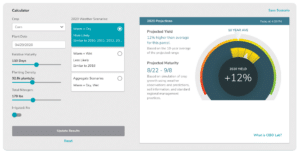
The less likely scenario for this particular parcel is Warm and Wet, which means that the weather predictions are warmer and wetter than the 30-year climatology for this particular parcel. The resulting yield is 18% higher than the 10-year average, and the maturity date range is between August 27 and September 3.
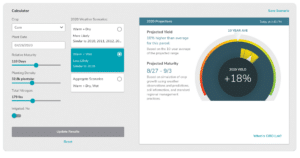
This is just one example of the types of experiments that can be done with the new Yield Simulator. As the season progresses, we learn more about the actual weather conditions. And via remote sensing, we can gain a better idea of how actual planting dates compare to projected planting, how many acres have been lost to adverse conditions, and how crop maturity is progressing. CIBO gives users the ability to save a scenario (a combination of crop, seeding rate, planting date, and nitrogen applications) so that they can come back as more information is known and see how projections evolve over time. To try the CIBO Lab Yield Simulator, click here.
About the Author
Adam Pasch is a Principal Data Scientist in Meteorology at CIBO, a science-driven software startup. He is a Certified Consulting Meteorologist from the American Meteorological Society. Prior to CIBO, Dr. Pasch was the Weather Data Strategy and Operations Manager at The Climate Corporation and a Meteorologist Project Manager at Sonoma Technologies, Inc. He holds a Doctorate, Masters, and Bachelors of Science in Meteorology from Saint Louis University.
For further information about CIBO Technologies‘ corn forecasting, please visit our website /cibo-lab
These materials have been prepared by CIBO Technologies based on publicly available sources. These materials are not research reports and are not intended as such. These materials are provided for informational purposes only and are not otherwise intended as an offer to sell, or the solicitation of an offer to purchase, any commodity future, swap, security or other financial instrument. These materials contain preliminary information that is subject to change and that is not intended to be complete or to constitute all of the information necessary to evaluate the consequences of entering into a transaction and/ or investing in any financial instruments. These materials also include information obtained from sources believed to be reliable, but CIBO does not warrant their completeness or accuracy. In no event shall CIBO be liable for any use by any party of, for any decision made or action taken by any party in reliance upon, or for any inaccuracies or errors in, or omissions from, the information contained in these materials and such information may not be relied upon by you in evaluating the merits of participating in any transaction. All displayed quotes and rates are meant for informational purposes only. They are not to be relied upon to make any trades nor are they meant as a recommendation to participate in a particular trade. There is risk in trading and due diligence should be performed before executing any trades. CIBO makes no representation as to the accuracy of the data. Trades can only be made through an account at a registered broker/dealer or futures commission merchant. CIBO is neither a futures commission merchant nor a registered broker / dealer. CIBO is not a SEF. All projections, forecasts and estimates of returns and other “forward-looking” statements are based on assumptions, which are unlikely to be consistent with, and may differ materially from, actual events or conditions. Such forward-looking information only illustrates hypothetical results under certain assumptions. Actual results will vary, and the variations may be material. Nothing herein should be construed as an investment recommendation or as legal, tax, investment or accounting advice.
Return to the pathway to build your knowledge of regenerative agriculture
Return to Pathway